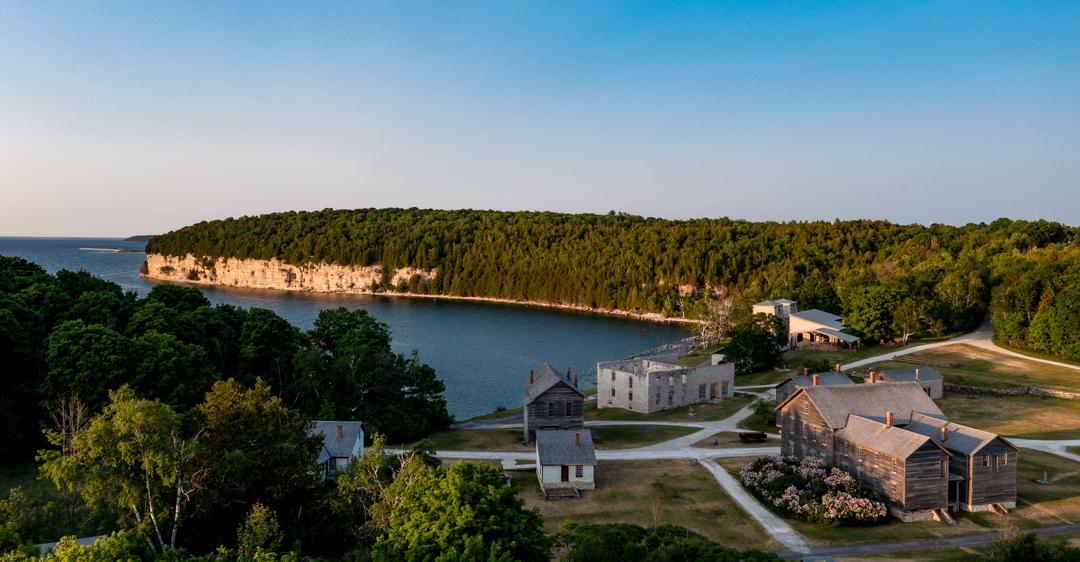
Fayette Historic State Park & Townsite
Explore Fayette Historic State Park & Townsite
You don’t have to travel far in Michigan’s Upper Peninsula to see how proudly we preserve and share our amazing history with generation after generation. One of the nation’s premier historic company townsites is on the Garden Peninsula in Fayette Historic State Park.
Plan to spend a minimum of two hours (you can easily fill a day) exploring the townsite’s visitor center and 20 buildings to learn how this little iron smelting town helped transform America between 1867 and 1891. If history isn’t your motivation to stop, then the recreational fun will be in this 711-acre park that wraps around Snail Shell Harbor off Lake Michigan’s Big Bay de Noc. Be sure to check out our Fayette blog, too!
HOW TO GET TO FAYETTE HISTORIC STATE PARK
The park is at 4785 II Road, Garden. From U.S. 2, take M-183 17 miles south through the Garden Peninsula.
Take me to Fayette Historic State Park!
HOURS AND ENTRANCE FEES
This year-round park is open from 8 a.m. to 10 p.m.; however, the historic townsite and campsites are only open from mid-May to mid-October and the boat slips from early May to early November.
- Registration Office: 9 a.m.-8 p.m., varies by season.
- Campsite: Check-in 3 p.m. Check-out 1 p.m.
- The Furnace Hill Lodge: Check-in 4 p.m. Check-out noon
- Quiet Hours: 10 p.m.-8 a.m.
- Office Phone: 906-644-2603.
To access the park, visitors and campers will need a current Michigan Recreational Passport. Non-residents can purchase passes when they arrive. These passes are good at all Michigan State Parks.
HISTORY OF FAYETTE HISTORIC STATE PARK
The peaceful townsite overlooking Snail Shell Harbor with its weathered buildings and stone furnaces is a far cry from Fayette’s booming days when noise and billowing smoke filled the soot-blackened air. The town’s founder, Fayette Brown, general manager of the Jackson Iron Company in Cleveland, Ohio, strategically chose this site for an iron smelting operation in 1867.
Brown knew the site’s proximity to the Upper Peninsula iron mines would lower Jackson Iron’s production costs. Being on the harbor would make it easier to transport people, supplies and iron ore to and from the remote town. The harbor’s ancient white limestone cliffs would be a nearby source of flux needed to purify the molten iron and for construction materials to build the town. Hundreds of acres of forests on the Garden Peninsula would provide wood for making charcoal to fuel the blast furnaces. Add the gorgeous scenery and Brown was confident if he built the company town here, workers would come.
Immigrants poured in from Canada, Britain and other northern European countries
Brown was right. In its heyday, approximately 500 residents called Fayette home. They produced nearly 230,000 tons of some of the best pig iron ingots in the country. The ingots were shipped to steel producers on the lower Great Lakes that converted them into railroad rails and the steel needed to build our fast-growing country.
This harbor community was more than the towering blast furnaces, charcoal and lime kilns and noisy machine shop. The townspeople played in a coronet band and on Fayette’s baseball team and they raced horses at the town’s track. A teacher taught children in the school. The company doctor cared for injuries and illnesses. Stagecoaches brought residents to and from Garden, Manistique and Escanaba. The hotel and its dining room were filled with guests.
There were, however, the haves and have-nots. Tradesmen, supervisors and their families lived in comfortable frame houses near the central business district. Laborers and their families stayed in rustic log cabins on the hills, along the lakeshore and the road on the other side of town. None of the laborers’ original housing still stands.
Fayette became a ghost town in 1891
Fayette’s success was short-lived. The blast furnaces devoured the area’s hardwoods and new methods for processing iron and making steel took the business to distant cities. Jackson Iron closed its Fayette operations in 1891. Most workers and their families moved to jobs in other towns. A few residents stayed in the area and the site, a ghost of its former self, became a tourist attraction.
In 1959, the State of Michigan acquired the townsite and surrounding acreage and made it a state park. Over the decades, they have stabilized the structures, created exhibits and installed interpretive signs that tell what life was like during these 24 years of America’s story.
Over 20 historic buildings create this walkable outdoor museum
When you arrive at the park, make your first stop at the visitor center. A large diorama of the townsite gives you a quick overview and exhibits about the ancient trees and the iron smelting process will familiarize you before you explore the townsite. Take a few minutes to visit the gift shop if it is open. Then, in the summer, join a free guided tour or take a self-guided tour from mid-May to mid-October.
In the townsite, there are 20 buildings, including 11 that house museum exhibits and interactive learning opportunities for children. You will stand next to the massive blast furnaces and the kilns for making charcoal, enter a school classroom and then see the hotel, company office, machine shop, warehouse, several still-standing residences and a replica of a laborer’s log cabin. Walk down to Slag Beach, which was once the town’s garbage dump. There you will see the furnace waste, a glass-like slag or cinder mixed with iron, strewn across the beach. You will learn from the signage that Fayette wasn’t the cleanest town in America.
Share the story with your children. Pack a picnic and eat it just like the town residents once did in the center of town. Talk about the hardships, the careless use of natural resources, the company’s unwillingness to change with the times and why it’s important to preserve our historic sites. There is a lot to be learned from this town’s past.
THINGS TO DO AT FAYETTE HISTORIC STATE PARK
Look out at the ancient cedars growing on the park’s limestone bluffs.
Some are 800, 900 and even 1,400 years old, making them the oldest trees in any Michigan state park!
Hike, bike, snowshoe, or ski overlooking limestone cliffs.
Three-and-a-half miles of scenic trails take you through hardwood forests, along the bluff, and through the townsite. In winter, the park grooms a single track for traditional cross-country skiing. Hard-packed trails are open to snowshoers and hikers.
Paddle or cruise past stunning scenery.
Fayette is a gorgeous place to kayak, canoe, stand-up paddleboard, or boat. The Snail Shell Harbor’s white limestone cliffs rival the beauty of the Pictured Rocks National Lakeshore on Lake Superior. You can easily navigate your pleasure craft or larger yacht in the harbor waters.
Reel in the big ones.
Big Bay de Noc rates as one of the best fishing areas in the Midwest. Experience the thrill of catching walleye, northern pike, perch and smallmouth bass.
Scuba dive or snorkel in search of artifacts and aquatic life.
Some of Fayette’s story can be found below the harbor’s surface. Scuba diving and snorkeling are only permitted at certain times; stop by the camp office to purchase the required permit. The Slag Beach, just off the townsite, is a popular exploration point. Please leave any discoveries in the water.
Below, join Mi Playground as they adventure around Fayette!
FAYETTE HISTORIC PARK EVENTS
Lantern-Lit Cross-Country Ski, Snowshoe & Hike
Last Saturday in January: 6-8 p.m. The park illuminates the 1.5-mile Bluff Trail with the soft glow of kerosene lanterns. A bonfire, hot cocoa and marshmallows add to the fun.
Christmas In June
Third Saturday in June: 11 a.m.-2 p.m. Campers decorate their campsites and join day visitors in family activities. The only thing missing is the snow!
Heritage Day
Second Saturday in August: 11 a.m.-4 p.m. This popular event recaptures the glory days of living in the townsite. See 19th-century cooking and blacksmithing demonstrations, listen to period music and watch (you’re also invited to play) an 1860s-style baseball game.
Paranormal Event
Third Weekend of September: 9 p.m.-3 a.m. Have you ever wondered what a ghost hunter does? Here’s your chance to participate in two nights of paranormal investigation on our eerie-at-night grounds, for ages 10 years or older.
Fall Fest
First Weekend of October: 11 a.m.-3 p.m. Hayrides, kids’ activities plus Halloween decorations and trick-or-treating in the campground.
Stay updated on event changes by following Fayette Historic State Park’s Facebook page!
WHERE TO STAY
Seasonal modern campsites, boat slips and a year-round lodge are available at Fayette Historic State Park. Make campsite and marina reservations up to six months in advance online at www.midnrreservations.com or Mon-Fri: 8 a.m.–8 p.m., or Sat-Sun: 9 a.m.–5 p.m. by calling 800-447-2757.
Campsites
Fayette Historic State Park has 61 sites; 50 with 20/30-amp electricity hookup; 11 pull-through with 20/30 & 50-amp hookup; individual fire circle and picnic table; shower and restroom facilities; you’ll be near the beach and townsite.
Boat camping
Pull into one of the 15 transient slips for 1’-38’, 20’-45’ and 46’-’60’ pleasure craft and yachts. Enjoy day or overnight dockage; 30/50-amp electrical pedestals; water and restrooms; you’re within walking distance of park amenities.
Hammock camping or just relaxing
This is a great park to set up your hammock at your site or string between two trees within the park and hang out for the day.
Year-round getaway lodge
The Furnace Hill Lodge sleeps up to 10 people and is available for by-the-day or weekly rentals year-round. It’s a serene, edge-of-the-woods getaway near the townsite, beach and trails, fully furnished and equipped with linens and kitchen utensils. Call for availability and reservations: 906-644-2603.
Pets are welcome
Campers and day visitors may bring their pets to the park as long as they are quiet and kept on a six-foot leash. For your pet’s and visitors’ safety, no pets are allowed in the historic buildings or on the swimming beaches. For more information, click here or call 906-644-2603.
Additional lodging is available in Escanaba and the Bays de Noc area.
OTHER NEARBY PLACES TO ADD TO YOUR ITINERARY
Sac Bay County Park
Located five miles south of the state park on M-183, it offers an uncrowded swimming beach, picnic area and wide-open view of the islands between Garden and Door Peninsulas. Another place to kayak and canoe.
Garden Peninsula Historical Museum
Housed in a one-room schoolhouse, it features stories about logging, fishing and going to school on the peninsula.
Sand Point Lighthouse
Circa 1867, this Escanaba landmark, was operated for 18 years by Mary Terry, one of the first women lighthouse keepers on the Great Lakes.
Kitch-iti-kipi, Palms Book State Park
A hand-crank ferry takes you across the crystal clear pond where the “Big Spring” gushes 10,000 gallons of water per minute.
Hiawatha National Forest
This is home to acres of hardwoods, inland lakes, motorized and non-motorized trails.





Join us on
Social